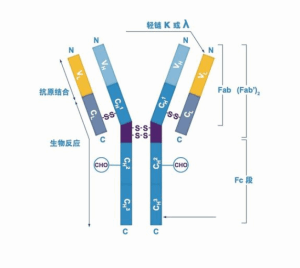英文名称Rabbit Anti-Proinsulin antibody
中文名称胰岛素原抗体
别 名INS_HUMAN; ILPR; INS; Insulin A chain; Insulin precursor; IRDN; Proinsulin; Proinsulin precursor.
抗体来源Rabbit
克隆类型Polyclonal
交叉反应Mouse,Rat (predicted: Human,Rabbit,Pig,Cow,Horse)
产品应用IHC-P=1:100-500,IHC-F=1:100-500,IF=1:100-500
not yet tested in other applications.
optimal dilutions/concentrations should be determined by the end user.
理论分子量5.8/12kDa
细胞定位分泌型蛋白
性 状Liquid
浓 度1mg/ml
免 疫 原KLH conjugated synthetic peptide derived from human Insulin: 46-59/110
亚 型IgG
纯化方法affinity purified by Protein A
缓 冲 液0.01M TBS (pH7.4) with 1% BSA, 0.02% Proclin300 and 50% Glycerol.
保存条件Shipped at 4℃. Store at -20℃ for one year. Avoid repeated freeze/thaw cycles.
注意事项This product as supplied is intended for research use only, not for use in human, therapeutic or diagnostic applications.
PubMedPubMed
产品介绍Insulin is a pancreatic hormone that regulates glucose and is involved in the synthesis of protein and fat. It increases cell permeability to monosaccharides, amino acids and fatty acids. It accelerates glycolysis, the pentose phosphate cycle, and glycogen synthesis in liver. Heterodimer of a B chain and an A chain linked by two disulfide bonds.Belongs to the insulin family. The insulin-link growth factors, IGF-I and IGF-II (also desinated somatomedin C and multiplication stimulating activator, respectvely), share approximatly 76% sequence identity and are 50% related to pro-insulin.IGF-I and IGF-II are nonglycosylated, single chain proteins of 70 and 76 amino acids in length, respectivelly. IGF-I functions as an autocrine regulator of growth in vaious, whereas the function of IGF-II is less well defined.
Function:
Insulin decreases blood glucose concentration. It increases cell permeability to monosaccharides, amino acids and fatty acids. It accelerates glycolysis, the pentose phosphate cycle, and glycogen synthesis in liver.
Subunit:
Heterodimer of a B chain and an A chain linked by two disulfide bonds.
Subcellular Location:
Secreted.
DISEASE:
Defects in INS are the cause of familial hyperproinsulinemia (FHPRI) [MIM:176730].
Defects in INS are a cause of diabetes mellitus insulin-dependent type 2 (IDDM2) [MIM:125852]. IDDM2 is a multifactorial disorder of glucose homeostasis that is characterized by susceptibility to ketoacidosis in the absence of insulin therapy. Clinical fetaures are polydipsia, polyphagia and polyuria which result from hyperglycemia-induced osmotic dieresis and secondary thirst. These derangements result in long-term complications that
Defects in INS are a cause of diabetes mellitus permanent neonatal (PNDM) [MIM:606176]. PNDM is a rare form of diabetes distinct from childhood-onset autoimmune diabetes mellitus type 1. It is characterized by insulin-requiring hyperglycemia that is diagnosed within the first months of life. Permanent neonatal diabetes requires lifelong therapy.
Similarity:
Belongs to the insulin family.
SWISS:
P01308
Gene ID:
3630

